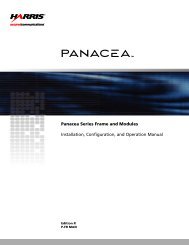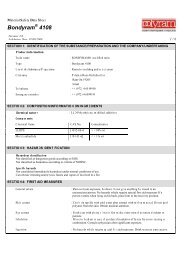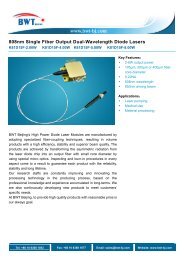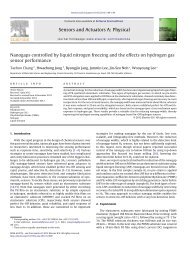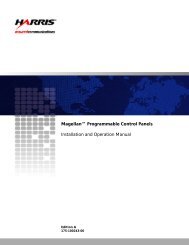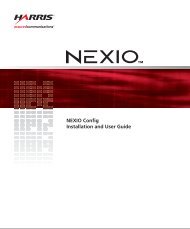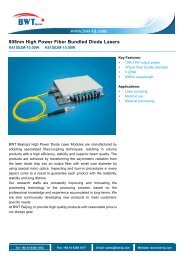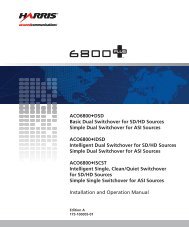SEL-FR3 Selenio Frame Installation and Operation ... - Biznine.com
SEL-FR3 Selenio Frame Installation and Operation ... - Biznine.com
SEL-FR3 Selenio Frame Installation and Operation ... - Biznine.com
Create successful ePaper yourself
Turn your PDF publications into a flip-book with our unique Google optimized e-Paper software.
Setting<br />
Control<br />
Parameters<br />
Physical<br />
<strong>SEL</strong>-<strong>FR3</strong><br />
<strong>Installation</strong> <strong>and</strong> <strong>Operation</strong> Manual<br />
This panel displays information about the frame’s environment, including whether various<br />
LEDs are active (indicating that there are faults with protective hardware in the system, such<br />
as fans <strong>and</strong> power supplies).<br />
The parameters in this panel group define the various <strong>com</strong>munications systems the frame<br />
can use for control.<br />
IP Settings<br />
Settings on this screen determine how the frame is controlled using the Browser Control<br />
interface (the interface described in this chapter). If you make a wrong choice on this<br />
screen, you could lose connection with the frame.<br />
Note: The controller module uses a VLAN (Virtual Local Area Network) to create a<br />
broadcast domain which all modules within the frame will use to <strong>com</strong>municate among<br />
themselves (for control <strong>and</strong> data traffic). A VLAN has the same attributes as a physical<br />
network, including subnet <strong>and</strong> ID properties. <strong>Selenio</strong> systems have default settings for<br />
Control <strong>and</strong> Data Subnet <strong>and</strong> VLAN IDs for both primary <strong>and</strong> secondary controller cards<br />
(parameters found in the 'Advanced IP Setting' area). Unless there is conflict with your own<br />
network settings, all these parameters should NOT be changed. If changes are required,<br />
please consult a Harris Customer Service representative. Failure to do so might result in<br />
improper control <strong>and</strong> monitoring of <strong>Selenio</strong> systems.<br />
The Data Ethernet settings described on this screen only affect frames where the controller<br />
module has an optional video IP submodule.<br />
Interface Settings<br />
This panel displays the current status of each control interface, <strong>and</strong> has buttons to enable<br />
<strong>and</strong> disable that interface. The interfaces available are:<br />
Front Panel—A hardware panel display on the front of your frame that, when<br />
installed, provides an opportunity for local control <strong>and</strong> monitoring when an operator is<br />
physically in front of the frame.<br />
FTP—The frame’s FTP interface, responsible for all file transfers.<br />
HTTP—The server that allows you to enter the IP address of the frame <strong>and</strong> control <strong>and</strong><br />
monitor the frame using a web browser.<br />
Note: If you disable the HTTP server on this screen, your browser will immediately lose its<br />
connection with the frame.<br />
SNMP—The agent responsible for implementing the SNMP interface that sends traps<br />
<strong>and</strong> allows parametric control via SNMP protocol.<br />
Telnet—The frame’s telnet interface, responsible for accessing the frame via telnet<br />
(mainly used for troubleshooting purposes).<br />
SSH—Used for internal <strong>com</strong>munications. Should not be disabled, unless directed to do<br />
so by Customer Service.<br />
CCSP—Interface responsible for implementing the CCSP interface, allowing clients<br />
(such as webpage, CCS Navigator, NUCLEUS, etc.) to control <strong>and</strong> monitor the frame.<br />
Copyright © 2011, Harris Corporation<br />
37



